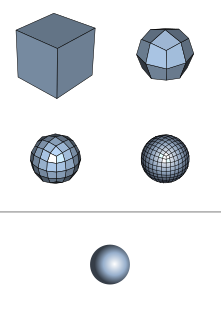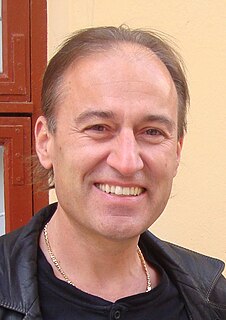
Rendering or image synthesis is the process of generating a photorealistic or non-photorealistic image from a 2D or 3D model by means of a computer program. The resulting image is referred to as the render. Multiple models can be defined in a scene file containing objects in a strictly defined language or data structure. The scene file contains geometry, viewpoint, texture, lighting, and shading information describing the virtual scene. The data contained in the scene file is then passed to a rendering program to be processed and output to a digital image or raster graphics image file. The term "rendering" is analogous to the concept of an artist's impression of a scene. The term "rendering" is also used to describe the process of calculating effects in a video editing program to produce the final video output.

Autodesk Maya, commonly shortened to just Maya, is a 3D computer graphics application that runs on Windows, macOS and Linux, originally developed by Alias Systems Corporation and currently owned and developed by Autodesk. It is used to create assets for interactive 3D applications, animated films, TV series, and visual effects.
Alias Systems Corporation, headquartered in Toronto, Ontario, Canada, was a software company that produced high-end 3D graphics software. The company was formed in 1995 when Silicon Graphics bought Alias Research, which was founded in 1983, and Wavefront Technologies, founded in 1984, then merged the two companies. It became part of Autodesk in 2006.

Autodesk Alias is a family of Computer-aided industrial design (CAID) software predominantly used in Automotive Design and Industrial Design for generating Class A surfaces using Bézier surface and NURBS modeling method.
In the field of 3D computer graphics, a subdivision surface is a curved surface represented by the specification of a coarser polygonal mesh and produced by a recursive algorithmic method. The curved surface, the underlying inner mesh, can be calculated from the coarse mesh, known as the control cage or outer mesh, as the functional limit of an iterative process of subdividing each polygonal face into smaller faces that better approximate the final underlying curved surface. Less commonly, a simple algorithm is used to add geometry to a mesh by subdividing the faces into smaller ones without changing the overall shape or volume.

ACM SIGGRAPH is the international Association for Computing Machinery's Special Interest Group on Computer Graphics and Interactive Techniques based in New York. It was founded in 1969 by Andy van Dam.

The Catmull–Clark algorithm is a technique used in 3D computer graphics to create curved surfaces by using subdivision surface modeling. It was devised by Edwin Catmull and Jim Clark in 1978 as a generalization of bi-cubic uniform B-spline surfaces to arbitrary topology.
Ronald Paul "Ron" Fedkiw is a full professor in the Stanford University department of computer science and a leading researcher in the field of computer graphics, focusing on topics relating to physically based simulation of natural phenomena and machine learning. His techniques have been employed in many motion pictures. He has earned recognition at the 80th Academy Awards and the 87th Academy Awards as well as from the National Academy of Sciences.

In 3D computer graphics, a Doo–Sabin subdivision surface is a type of subdivision surface based on a generalization of bi-quadratic uniform B-splines, whereas Catmull-Clark was based on generalized bi-cubic uniform B-splines. The subdivision refinement algorithm was developed in 1978 by Daniel Doo and Malcolm Sabin.

Fluid animation refers to computer graphics techniques for generating realistic animations of fluids such as water and smoke. Fluid animations are typically focused on emulating the qualitative visual behavior of a fluid, with less emphasis placed on rigorously correct physical results, although they often still rely on approximate solutions to the Euler equations or Navier–Stokes equations that govern real fluid physics. Fluid animation can be performed with different levels of complexity, ranging from time-consuming, high-quality animations for films, or visual effects, to simple and fast animations for real-time animations like computer games.

In computer graphics, the Loop method for subdivision surfaces is an approximating subdivision scheme developed by Charles Loop in 1987 for triangular meshes. Prior methods, namely Catmull-Clark and Doo-Sabin (1978), focused on quad meshes.

Computer graphics is a sub-field of computer science which studies methods for digitally synthesizing and manipulating visual content. Although the term often refers to the study of three-dimensional computer graphics, it also encompasses two-dimensional graphics and image processing.

Computer graphics deals with generating images with the aid of computers. Today, computer graphics is a core technology in digital photography, film, video games, cell phone and computer displays, and many specialized applications. A great deal of specialized hardware and software has been developed, with the displays of most devices being driven by computer graphics hardware. It is a vast and recently developed area of computer science. The phrase was coined in 1960 by computer graphics researchers Verne Hudson and William Fetter of Boeing. It is often abbreviated as CG, or typically in the context of film as computer generated imagery (CGI). The non-artistic aspects of computer graphics are the subject of computer science research.
The history of computer animation began as early as the 1940s and 1950s, when people began to experiment with computer graphics - most notably by John Whitney. It was only by the early 1960s when digital computers had become widely established, that new avenues for innovative computer graphics blossomed. Initially, uses were mainly for scientific, engineering and other research purposes, but artistic experimentation began to make its appearance by the mid-1960s- most notably by Dr Thomas Calvert. By the mid-1970s, many such efforts were beginning to enter into public media. Much computer graphics at this time involved 2-dimensional imagery, though increasingly as computer power improved, efforts to achieve 3-dimensional realism became the emphasis. By the late 1980s, photo-realistic 3D was beginning to appear in film movies, and by mid-1990s had developed to the point where 3D animation could be used for entire feature film production.

Markus Gross is a Professor of Computer science at the Swiss Federal Institute of Technology Zürich (ETH), head of its Computer Graphics Laboratory, and the director of Disney Research, Zurich. His research interests include physically based modeling, computer animation, immersive displays, and video technology. He has published more than 400 scientific papers on algorithms and methods in the field of computer graphics and computer vision, and holds more than 30 patents. He has graduated more than 50 PhD students so far.

Duncan Brinsmead is a Canadian software programmer and developer of simulations of natural environments in 3D computer graphics (CGI). He created the Maya Paint Effects for digitally painting instances like plants or hair in a virtual 3D environment. In 2008, together with Jos Stam, Julia Pakalns and Martin Werner he received an Academy Award for Technical Achievement for the design and implementation of the Maya Fluid Effects system. Fluid Effects are based on the simulation of fluid mechanics in software and used for simulating natural phenomena such as fog, steam or smoke.
Arnold is a computer program for rendering three-dimensional, computer-generated scenes using unbiased, physically-based, Monte Carlo path tracing techniques. Created in Spain by Marcos Fajardo and later co-developed by his company Solid Angle SL and Sony Pictures Imageworks, Arnold is one of the most widely used photorealistic rendering systems in computer graphics worldwide in 2021, specially in animation and VFX for film and TV. Notable feature films that have used Arnold include Monster House, Cloudy with a Chance of Meatballs, Alice in Wonderland, Thor, Captain America, X-Men: First Class, The Avengers, Space Pirate Captain Harlock, Elysium, Pacific Rim, Gravity, Guardians of the Galaxy, Star Wars: The Force Awakens, Arrival and Blade Runner 2049. Notable television series include Game of Thrones, Westworld, Trollhunters and LOVE DEATH + ROBOTS.

Demetri Terzopoulos is a Distinguished Professor of Computer Science in the Henry Samueli School of Engineering and Applied Science at the University of California, Los Angeles, where he directs the UCLA Computer Graphics & Vision Laboratory.

The Dynamic Graphics Project is an interdisciplinary research laboratory at the University of Toronto devoted to projects involving Computer Graphics, Computer Vision, and Human Computer Interaction. The lab began as the computer graphics research group of Computer Science Professor Leslie Mezei in 1967. Mezei invited Bill Buxton, a pioneer of human–computer interaction to join. In 1972, Ronald Baecker, another HCI pioneer joined dgp, establishing dgp as the first Canadian university group focused on computer graphics and human-computer interaction. According to csrankings.org, for the combined subfields of computer graphics, HCI, and visualization the dgp is the Number One research institution in the world.

Michael Kass is an American computer scientist best known for his work in computer graphics and computer vision. He has won an Academy Award and the SIGGRAPH Computer Graphics Achievement Award and is an ACM Fellow.















